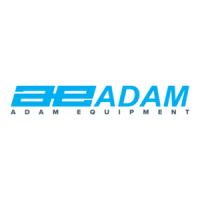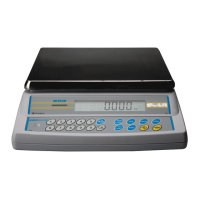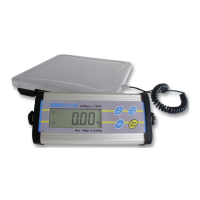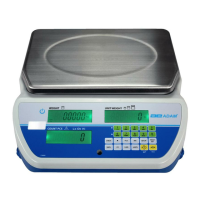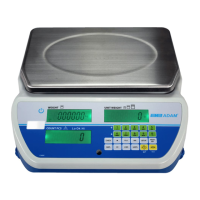Do you have a question about the Adam Equipment CBD 4 and is the answer not in the manual?
Details the specifications for the local scale, including capacity, readability, and tare range.
Details the specifications for the remote scale, covering excitation, signal range, and load cell compatibility.
Lists common technical specifications applicable to all scales in the series, such as interface and dimensions.
Guidelines for selecting an optimal location for the scale to ensure accurate readings and performance.
Instructions on how to physically set up the scale, including platform placement and leveling.
Steps for setting up the remote scale, connecting it, leveling, and selecting local or remote operation.
Details the function of each key on the scale's keypad, including numeric, control, and function keys.
Describes the 6-digit weight display, its indicators for battery, stability, zero, and units.
Explains the unit weight display, how it's shown, and indicators for insufficient samples or inaccurate unit weight.
Details the count window, indicators for checkweighing, limits, and the battery charging LED status.
Instructions on how to zero the scale and perform tare operations using both automatic and manual methods.
Explains how to use the memory functions, including manual and automatic accumulation of weighings.
Details the process of manually adding weighings to the accumulator and how to view or clear the memory.
Describes how to enable automatic accumulation of totals, reducing the need for manual key presses.
Guide on how to weigh a sample to determine the average unit weight for accurate parts counting.
Instructions on manually entering a known unit weight for parts counting if sample weighing is not feasible.
Explains the automatic unit weight update feature and how to lock the unit weight to prevent changes.
Describes how to set preset limits for counting or weighing to trigger alarms when thresholds are met.
Step-by-step guide on how to manually store PLU data, including tare and unit weights.
Instructions for manually entering descriptions for PLU items, detailing character input and limitations.
Procedure for manually recalling stored PLU information, including tare and unit weight data.
Details on how to set and configure the real-time clock for RS-232 output and date/time formats.
Describes the RS-232 connector pinout and specifications for connecting to external devices.
Details the USB connector type and availability of software drivers for PC connectivity.
Explains the format and structure of commands that can be sent to the scale for control and data entry.
Instructions on how to store user ID, scale ID, and PLU text data using RS-232 commands.
Method for sending PLU data, including Tare Weight, Unit Weight, and Description, from a PC using RS-232.
Information required regarding the user's company for service and support requests.
Details about the purchased scale, including model, serial number, and purchase date, for service.
A section to describe any problems encountered with the scale for effective technical assistance.
| Capacity | 4 kg |
|---|---|
| Readability | 0.1 g |
| Display | LCD |
| Calibration | External |
| Interface | RS-232 |
| Auto-off | Yes |
| Tare Range | Full Capacity |
| Power Supply | AC Adapter |
| Units of Measurement | g, lb, oz |
| Material | Stainless steel |
